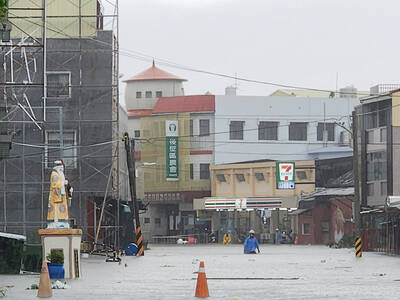Farming plankton, sending solar panels into orbit, remodeling hydrogen — for the latest wave of entrepreneurs suggesting easier ways out of climate change, it’s all in a day’s pitching.
Beyond grabbing headlines, such notions are attracting serious scientific attention and venture funding from investors who at least until the collapse of Lehman Brothers lent credibility to high-risk investment propositions.
Some plans seek radical alternatives to fossil fuels. Other businesses are dreaming of geoengineering — planning to tweak the earth’s climate by removing heat-trapping carbon dioxide or reflecting sunlight into space.

PHOTO: REUTERS
Among new energy fixes presented to Reuters in recent days is US-based BlackLight Power.
The company says it may have tapped the energy that cosmologists have struggled to explain, called dark matter, which fills the universe. The concept involves shifting electrons in hydrogen molecules — obtained cheaply from water — into a lower orbit, releasing energy in the process.
“It represents a boundless form of new primary energy,” founder Randell Mills said in a phone interview.
“I think it’s going to replace all forms of fuel in the world,” he said.
Britain’s top science academy, the Royal Society, this week urged more funds be channelled into research on geoengineering, but for some climate commentators the unproven, technical solutions smack of society’s craving for pain-free get-outs.
They said politicians might prefer to feed that habit rather than face tough choices in redressing global warming.
Greenpeace chief scientist Doug Parr said geoengineering projects would be seized upon by polluters as a quick fix, and the former climate change adviser to oil firm BP said they were simplistic.
“People are being naive ... looking for a technological fix,” said Chris Mottershead, who is now head of research and innovation at King’s College London.
“Anything of the necessary scale will have its own unintended consequences, even if they are not recognized at the moment,” he said.
Since 1991, BlackLight’s founder said his company has raised US$60 million from private investors who have included the former chairman of Morgan Stanley, Dick Fisher and the bank’s now retired head of energy. Mills says his goal is to produce a 250 kilowatt prototype by the end of next year.
The estimated capital cost of the energy at US$500/KW would be less than coal power, one of the cheapest forms of energy now. Several utilities have bought licences, in case it works.
Last month New Jersey-based Rowan University engineers said the BlackLight process in the lab had produced heat some 1.6-6.5 times beyond levels that can be easily explained.
“It does portend some type of novel energy source,” said Peter Jansson, associate engineering professor at Rowan.
In another energy fix, California-based Solaren wants to launch solar panels into orbit to send back radio waves which can generate electricity back on Earth — and benefit from the sun shining 24 hours a day in space.
“It’s not like a laser or a bug zapper or anything like that,” founder and CEO Gary Spirnak said. “I think this could be like any other large power source, 20-25 percent of the world’s electricity, 30 or 40 years out.”
Solaren aims to produce electricity from a 200 megawatt prototype by 2016 at a cost of several billions of dollars per plant.
“It’s a little expensive for a 200 megawatt plant. We’ll do a bit better than break even,” he said.
Spirnak said his company has raised “the equivalent of US$20-30 million from financial groups and private investors” and signed a power-purchase agreement with Californian utility PG&E, whose Web site shows a request for approval for power generated in this way from California’s Public Utilities Commission.
In case the world can’t contain its carbon emissions, among geoengineering fixes, Dan Whaley, founder and chief executive of California-based Climos, hopes tiny plankton that live on the ocean surface can be used to absorb carbon dioxide as they grow.
“These are not silver bullet solutions, but things that might take the edge off,” he said. “What is the risk of doing nothing? We think it’s so extraordinary it’s apocalyptic. These geoengineering projects, the research into this, is an exercise to reduce future risk.”
Global plankton deployment across 40 percent of the world’s oceans for 50 to 100 years could remove 1 billion to 8 billion tonnes of carbon emissions per year from the air, he said. That compares with annual manmade emissions now of about 32 billion tonnes.
Whaley, who says he has raised US$3.5 million from investors, plans to roll out the scheme over five or 10 years on a very small scale, “to increase our ability to model the environment.”
But he acknowledges a risk. Experts have pointed out that the plankton that die will sink several kilometers to the ocean’s depths, a rotting mass that may create oxygen-starved, dead zones on the floor of the oceans — a toxic prospect.

Rainfall is expected to become more widespread and persistent across central and southern Taiwan over the next few days, with the effects of the weather patterns becoming most prominent between last night and tomorrow, the Central Weather Administration (CWA) said yesterday. Independent meteorologist Daniel Wu (吳德榮) said that based on the latest forecast models of the combination of a low-pressure system and southwesterly winds, rainfall and flooding are expected to continue in central and southern Taiwan from today to Sunday. The CWA also warned of flash floods, thunder and lightning, and strong gusts in these areas, as well as landslides and fallen

WAITING GAME: The US has so far only offered a ‘best rate tariff,’ which officials assume is about 15 percent, the same as Japan, a person familiar with the matter said Taiwan and the US have completed “technical consultations” regarding tariffs and a finalized rate is expected to be released soon, Executive Yuan spokeswoman Michelle Lee (李慧芝) told a news conference yesterday, as a 90-day pause on US President Donald Trump’s “reciprocal” tariffs is set to expire today. The two countries have reached a “certain degree of consensus” on issues such as tariffs, nontariff trade barriers, trade facilitation, supply chain resilience and economic security, Lee said. They also discussed opportunities for cooperation, investment and procurement, she said. A joint statement is still being negotiated and would be released once the US government has made

SOUTH CHINA SEA? The Philippine president spoke of adding more classrooms and power plants, while skipping tensions with China over disputed areas Philippine President Ferdinand Marcos Jr yesterday blasted “useless and crumbling” flood control projects in a state of the nation address that focused on domestic issues after a months-long feud with his vice president. Addressing a joint session of congress after days of rain that left at least 31 dead, Marcos repeated his recent warning that the nation faced a climate change-driven “new normal,” while pledging to investigate publicly funded projects that had failed. “Let’s not pretend, the people know that these projects can breed corruption. Kickbacks ... for the boys,” he said, citing houses that were “swept away” by the floods. “Someone has

‘CRUDE’: The potential countermeasure is in response to South Africa renaming Taiwan’s representative offices and the insistence that it move out of Pretoria Taiwan is considering banning exports of semiconductors to South Africa after the latter unilaterally downgraded and changed the names of Taiwan’s two representative offices, the Ministry of Foreign Affairs (MOFA) said yesterday. On Monday last week, the South African Department of International Relations and Cooperation unilaterally released a statement saying that, as of April 1, the Taipei Liaison Offices in Pretoria and Cape Town had been renamed the “Taipei Commercial Office in Johannesburg” and the “Taipei Commercial Office in Cape Town.” Citing UN General Assembly Resolution 2758, it said that South Africa “recognizes the People’s Republic of China (PRC) as the sole